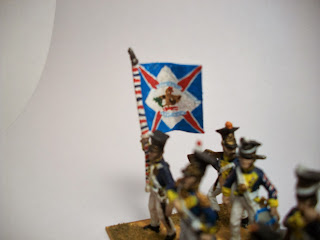Hello everyone!
Thanksgiving Break has arrived! I had my last class before the holidays today, which means I had a night to work on hobbies without stress from homework and whatnot. I spent that time painting up the guys I mentioned in my last post: the beginnings of a Portuguese line infantry regiment! Tonight I present the Coronel stand of the 21o Regimento de Valencia of the Exército Português. (Remember to click on the pictures for bigger versions.)
I'll tell you all the truth about this stand of figures: none of them were sold to me as "Portuguese." These six figures represent three different miniature manufacturers and two different nationalities, neither of which, like I said, were Portuguese. Keen observers will notice that the colonel (or coronel in Portuguese) and the drummer were pictured earlier on this blog in the white for the Salamanca Summer Painting Challenge 2012 as part of my British command stand (that I failed to start, let alone complete) for the Battle of New Orleans. They are British figures in Belgic shakos made by Eureka, and they are wonderful sculpts, very similar in size and style to AB figures. The two standard bearers are American figures made by Blue Moon Manufacturing, and the two rankers in the back row are British line infantry in Belgic shakos that I'm pretty sure are Minifigs.
I can already hear the gripes: Hey Chuck, how could you use these varied models to represent Portuguese? Won't there be inaccuracies? Good questions! One thing I've learned through painting 15mm figures is that the most important things that differentitate units on the tabletop at this scale are hats and equipment. Minor differences in arms and uniforms can generally be disguised by paint, but if the hats and equipage is wrong then they are a no-go. In this case, the Belgic shakos of the British figures and the leather shakos of the Americans--both of which had false fronts--are pretty close proxies of the Barretina shakos that were introduced by the Portuguese Army in 1806. Add in the fact that officer uniforms at the time were pretty much standard between most armies (to cover the colonel and standard bearers) and that Portugal accepted lots of donated equipment from Britain (to cover the rankers) and this mix of figures works pretty well together as Portuguese on the tabletop. I will be using more Minifigs British in Belgic shakos to represent the rest of the regiment. Inaccurate? Yes, but one would have to be a die-hard button-counter to be able to tell at this scale.
I've painted these lads in the dark blue tunics and white trousers that are seen in most illustrations of Portuguese infantry at this time. Portugal during the Peninsular Campaign was divided into three military divisions: the North, the Center and the South. Regiments from the Northern Division were presecribed to wear uniforms faced in yellow and carry yellow regimental colors, and I've reflected that here. Individual regiments were differentiated via differing piping and button colors. I've painted this stand as having both the King's color (the red and blue checked one) and the Regimental color together on the same stand. Both are made from glue-stiffened paper and hand-painted by myself--these flags proved a challenge in their complexity! Nominally Portuguese infantry regiments were divided into two battalions, with the first battalion carrying the King's color and the second battalion carrying the Regimental color. However, most of the evidence that I found indicated that for most of the Peninsular Campaign the 21o did not posess enough soldiers to flesh out two full battalions and instead the regiment formed a single battalion, hence both flags being in the same battalion. The 21o's sister regiment, the 9a Regimento de Viana, which served with the 21o in General Manley Power's (great name!) Portuguese Brigade in the British 3rd Division, was much larger and fought with two separate battalions for most if not all of the Peninsular War.
Whew! That's a lot of text!
Coming up: Those darn 3e Hussars. I've even included a workbench photo of them just to prove that I am in fact working on them:
These guys should get finished off tomorrow, then we'll see what else I get done. Maybe some more Portuguese... the rankers were really quick to paint up.
Questions, comments and criticisms are always welcomed and appreciated. Thanks for looking!
-Chuck




















































